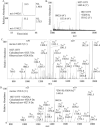Identification of the major site of O-linked beta-N-acetylglucosamine modification in the C terminus of insulin receptor substrate-1
- PMID: 16244361
- PMCID: PMC2435407
- DOI: 10.1074/mcp.M500314-MCP200
Identification of the major site of O-linked beta-N-acetylglucosamine modification in the C terminus of insulin receptor substrate-1
Abstract
Signal transduction from the insulin receptor to downstream effectors is attenuated by phosphorylation at a number of Ser/Thr residues of insulin receptor substrate-1 (IRS-1) resulting in resistance to insulin action, the hallmark of type II diabetes. Ser/Thr residues can also be reversibly glycosylated by O-linked beta-N-acetylglucosamine (O-GlcNAc) monosaccharide, a dynamic posttranslational modification that offers an alternative means of protein regulation to phosphorylation. To identify sites of O-GlcNAc modification in IRS-1, recombinant rat IRS-1 isolated from HEK293 cells was analyzed by two complementary mass spectrometric methods. Using data-dependent neutral loss MS3 mass spectrometry, MS/MS data were scanned for peptides that exhibited a neutral loss corresponding to the mass of N-acetylglucosamine upon dissociation in an ion trap. This methodology provided sequence coverage of 84% of the protein, permitted identification of a novel site of phosphorylation at Thr-1045, and facilitated the detection of an O-GlcNAc-modified peptide of IRS-1 at residues 1027-1073. The level of O-GlcNAc modification of this peptide increased when cells were grown under conditions of high glucose with or without chronic insulin stimulation or in the presence of an inhibitor of the O-GlcNAcase enzyme. To map the exact site of O-GlcNAc modification, IRS-1 peptides were chemically derivatized with dithiothreitol following beta-elimination and Michael addition prior to LC-MS/MS. This approach revealed Ser-1036 as the site of O-GlcNAc modification. Site-directed mutagenesis and Western blotting with an anti-O-GlcNAc antibody suggested that Ser-1036 is the major site of O-GlcNAc modification of IRS-1. Identification of this site will facilitate exploring the biological significance of the O-GlcNAc modification.
Figures





References
-
- Hart GW. Dynamic O-linked glycosylation of nuclear and cytoskeletal proteins. Annu. Rev. Biochem. 1997;66:315–335. - PubMed
-
- Comer FI, Hart GW. Reciprocity between O-GlcNAc and O-phosphate on the carboxyl terminal domain of RNA polymerase II. Biochemistry. 2001;40:7845–7852. - PubMed
-
- Slawson C, Hart GW. Dynamic interplay between O-GlcNAc and O-phosphate: the sweet side of protein regulation. Curr. Opin. Struct. Biol. 2003;13:631–636. - PubMed
-
- Iyer SP, Hart GW. Dynamic nuclear and cytoplasmic glycosylation: enzymes of O-GlcNAc cycling. Biochemistry. 2003;42:2493–2499. - PubMed
Publication types
MeSH terms
Substances
Grants and funding
LinkOut - more resources
Full Text Sources
Molecular Biology Databases

